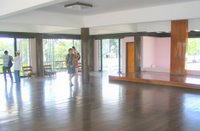First Look at
We started our four day stay in  President Nguyen Van Thieu in this building. It was also at this site, on
President Nguyen Van Thieu in this building. It was also at this site, on  April 30, 1975 tanks lead by number 843 crashed through the front gates marking the end of a very long war.
April 30, 1975 tanks lead by number 843 crashed through the front gates marking the end of a very long war.
 The building has been preserved much the way it looked on that spring day in 1975. Time has had a hand, however, in how the building is seen today. With a nod to the distance traveled since the war days, the front of the building was not draped with red
The building has been preserved much the way it looked on that spring day in 1975. Time has had a hand, however, in how the building is seen today. With a nod to the distance traveled since the war days, the front of the building was not draped with red banners of hammers and sickles. Rather, multistory banners advertising Cannon cameras hung from the front façade. Replicas of the tanks that burst onto the compound stood silently beneath shady trees.
banners of hammers and sickles. Rather, multistory banners advertising Cannon cameras hung from the front façade. Replicas of the tanks that burst onto the compound stood silently beneath shady trees.
 We took a one hour tour of the building with an English-speaking young Vietnamese guide. We visited spacious hallways
We took a one hour tour of the building with an English-speaking young Vietnamese guide. We visited spacious hallways and rooms that were well appointed, but lacked warmth. The building has been described from “modern” to “tacky”, but was a marvel of its time when it was designed by Paris-trained Vietnamese architect Ngo Viet Thu. We visited diplomatic reception rooms, conference rooms, the first lady’s salon, the game/gambling room, the president’s private movie salon and the top floor open air dance room, which was right next to the
and rooms that were well appointed, but lacked warmth. The building has been described from “modern” to “tacky”, but was a marvel of its time when it was designed by Paris-trained Vietnamese architect Ngo Viet Thu. We visited diplomatic reception rooms, conference rooms, the first lady’s salon, the game/gambling room, the president’s private movie salon and the top floor open air dance room, which was right next to the 
 rooftop helicopter landing pad. Once we headed to the basement and saw the bomb shelters, map rooms and communication center, the image of this building’s place in history became
rooftop helicopter landing pad. Once we headed to the basement and saw the bomb shelters, map rooms and communication center, the image of this building’s place in history became apparent.
apparent.
 Frozen in time are maps indicating areas of operations for various military units. Dozens of teletype machines once noisily communicating information in a pre-Internet era sat silently in their own room.
Frozen in time are maps indicating areas of operations for various military units. Dozens of teletype machines once noisily communicating information in a pre-Internet era sat silently in their own room.
We ended our tour with a short English narrated film on the history of the “American War” and the eventual victory of the People’s Liberation Army. It was a little tough to take the repeated reference in the film to “American imperialism,” but overall the tone  at the
at the

0 Comments:
Post a Comment
<< Home